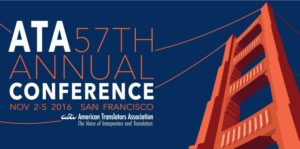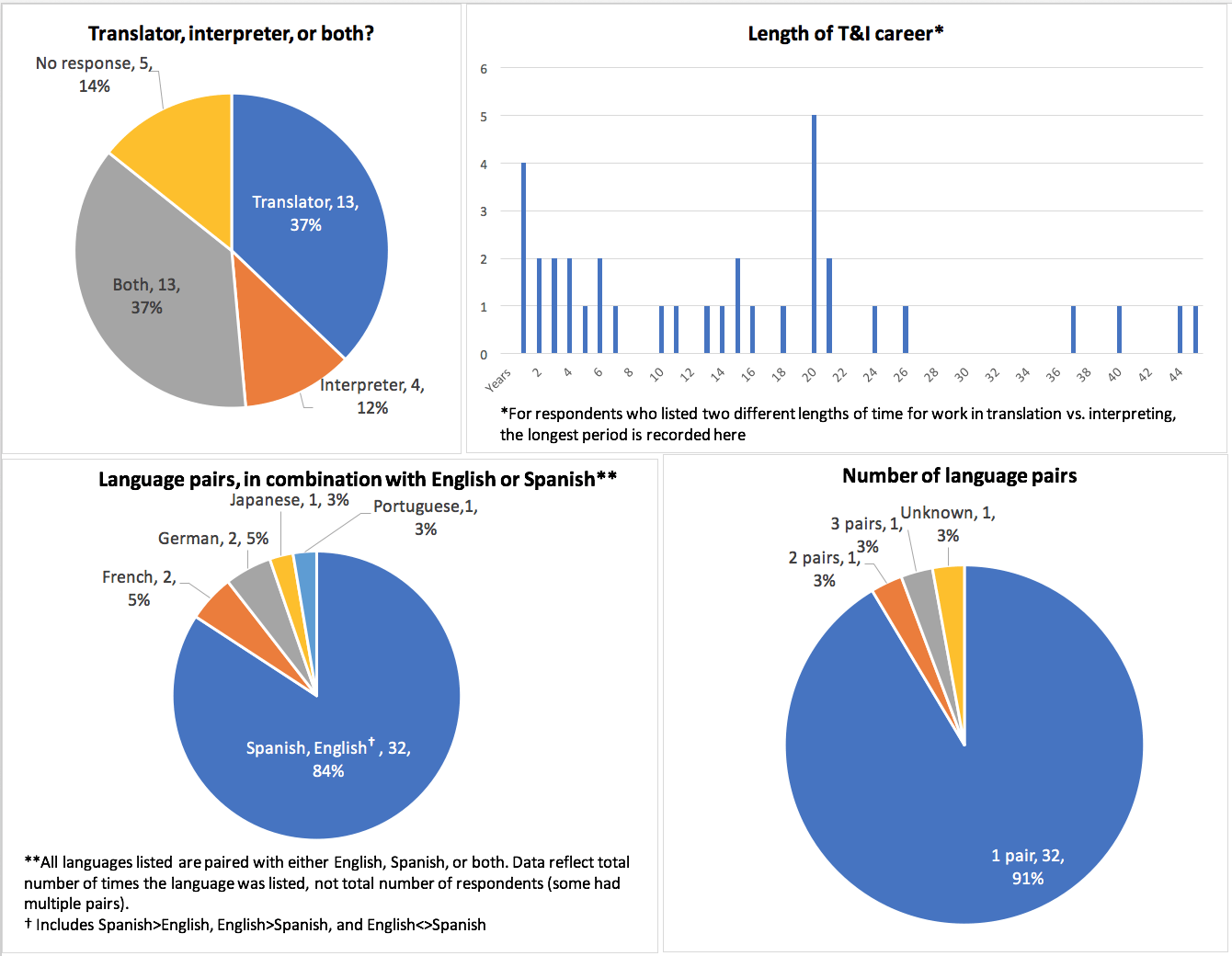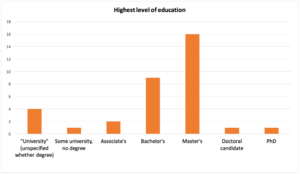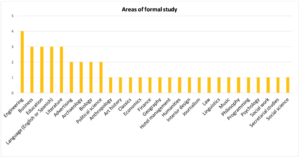The Extraordinary Translator and Interpreter: A Mini-Survey from ATA57
 In just one week, nearly 2,000 translators and interpreters will convene at ATA’s 58th Annual Conference. Memories of last year’s event abound, and The Savvy Newcomer is pleased to present the results of a mini-survey we conducted at the 57th Annual Conference in San Francisco whose goal was to examine trends in the backgrounds of translators and interpreters, particularly those who have enjoyed long careers in the field.
In just one week, nearly 2,000 translators and interpreters will convene at ATA’s 58th Annual Conference. Memories of last year’s event abound, and The Savvy Newcomer is pleased to present the results of a mini-survey we conducted at the 57th Annual Conference in San Francisco whose goal was to examine trends in the backgrounds of translators and interpreters, particularly those who have enjoyed long careers in the field.
Some of the aspects we looked at in the survey were: highest level of education, areas of study, how often translators and interpreters transition to these fields from a prior career, and for those who have transitioned, the ways in which their prior professional experience has influenced their careers as linguists.
The survey, and who responded
To conduct this survey, postcard questionnaires were handed out randomly to attendees at the Conference. We received a total of 35 completed postcards, which were processed by our team and evaluated for trends. What we found surprised us. To start, here is a breakdown of the basic demographics of our sample:
- Translator, interpreter, or both?: 13 translators, 13 translator-interpreters, 4 interpreters, 5 no response
- Length of T&I career: Average of 13.85 years (range: 1 to 44 years)
- Language combinations: Overwhelmingly Spanish-English—in one direction or bidirectional (32 respondents, 91.4%); but French (2), German (2), Japanese (1), and Portuguese (1) were also listed in combination with either English or Spanish.
- Number of language pairs: The majority had one working language pair (32, 91.4%), whereas only 3 (8.57%) had two or more language pairs.
Translators and interpreters appear to be highly educated—well beyond the general population
Some of the most compelling findings were in relation to prior studies completed by those surveyed. Of those who responded to the question “What is your highest level of educational achievement?”, 82.86% (29) had earned an associate’s degree or higher (the remaining 5 respondents had completed university courses, but 4 did not specify whether they had completed a degree). A striking 47.5% (16) reported having earned a master’s degree as their highest educational achievement, while approximately 25%* (9) held at least a bachelor’s. (*The responses of the 4 mentioned above who did not specify their highest university degree suggested they had earned at least a bachelor’s, which would bring the total of bachelor’s to 36.43%.) One respondent held a PhD (1), and another was a doctoral candidate (1) at the time of the survey.
Respondents had earned degrees in 16 different countries (with some overlap): Argentina, Canada, Colombia, Costa Rica, Cuba, Ecuador, France, Germany, Mexico, Peru, Puerto Rico, Spain, Uruguay, Venezuela, the United Kingdom, and the United States.
Prior studies: from A to T
There were a total 29 prior fields of study reported, including T&I. Seven (20%) reported having studied T&I, of whom one held a master’s in translation and another a bachelor’s, whereas the other 5 reported having participated in a certificate or other non-degree program. Most fascinating was the incredible variety of areas of study beyond T&I itself. There was truly a range from A to Z (well, to T for translation, to be precise!): from art history to social work, advertising to computer programming, finance to music, education to philosophy, and interior design to hotel management. We also saw journalism, linguistics, psychology, law, anthropology, and geography. Of the 29 fields reported, 9 had some overlap: engineering (4, 11.42%), business (3, 8.57%), education (8.57%), Spanish or English (8.57%), literature (8.57%), advertising (2, 5.71%), archaeology (5.71%), biology (5.71%), and political science (5.71%).
Getting a leg up from prior careers or studies
Most respondents shared stories of how past professional experience and academia had bolstered their careers in T&I. Below are just a few examples—some expected, and others less so:
- Engineering and biology (master’s): Academic knowledge leveraged in medical translation
- Political science, philosophy, economics, journalism (master’s): Benefit of strong research skills and experience reading foreign-language sources
- Psychology (master’s): Communication and listening skills, understanding of human behavior
- Chemical engineering, literature (master’s): Grasp of “implicit information” in source texts
- Finance (bachelor’s): The ins and outs of working as an independent contractor
- Social work, hotel management, law: Understanding international clients and medical content
- Mechanical engineering: Context for technical translation
- Social science, geography/geographic information systems (GIS), anthropology: Appreciation of the importance of language access after working with low-income, at-risk families and inmates
- Advertising: Marketing one’s own business
Making the switch to T&I
The reasons respondents gave for switching from another career to T&I were varied: While some felt the need for a change and decided to intentionally put their language skills to use, others seemed to find themselves in the career inadvertently and never left.
Some found a need in the community (years translating or interpreting in parentheses; T=translator, I=interpreter, T-I=translator-interpreter):
- “Somebody heard me at the hospital helping my mom” (13 years, I)
- “The need of people who speak Spanish” (20 years, T-I)
- “Increasing need in community where I worked” (3 years, T)
Others had “dabbled” in T&I as part of a past career and apparently discovered a passion for it:
- “Already working as bilingual aide, I was hired as translator” (16 years, T-I)
- “Part-time job interpreting, liked it a lot” (7 years, I; 4 years, T)
- “Through my work as a Spanish instructor because I started proofing” (3 years, T)
Yet others saw an opportunity to make some extra cash, and for some, the work became a lifelong career:
- “Needed money in grad school” (37 years, T)
- “Became a freelancer because I quit my other job” (20 years, T)
- “Plans for retirement” (2 years, T)
- “At the suggestion of a friend, because I couldn’t find professional work in the US (and I wasn’t going to make coffee)” (14 years, I)
Considering the relatively small sample of 35 respondents, the variation in experiences observed was remarkable, leading us to conclude that the individuals behind the professions of T&I, the paths that led them there, and their specialized knowledge, are as diverse as the languages they speak and the countries they hail from. Aside from their current careers, the one thing they seemed to have in common was an impressive level of formal education.
To think that these 35 individuals make up only a tiny fraction of the attendees at the ATA Conference each year brings into perspective just how magnificent our colleagues are. Whether you have plans to attend a local conference or meet-up this fall, or plan to join the ATA Conference in Washington, DC, you can be sure you will be in extraordinary company.



